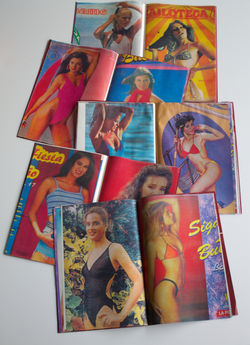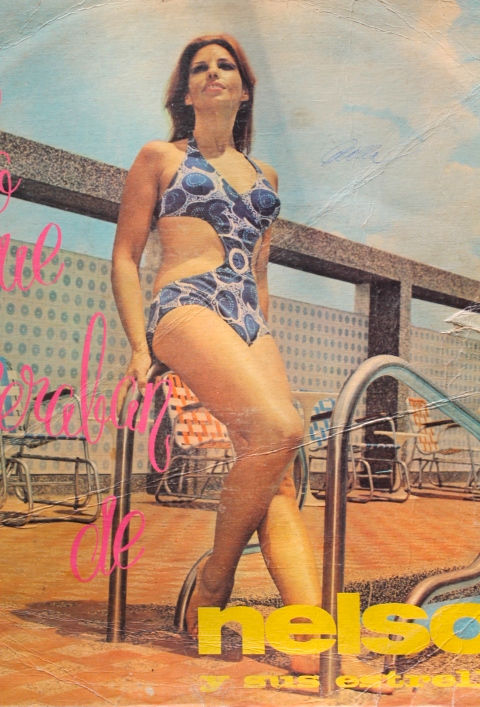DANIELA ARIZA


 |  |  |
|---|







































Expuestas
Fotografía Digital - Fotografía de archivo
30cm x 20cm
2016
Expuestas nació un día en el que estaba buscando acetatos viejos en el centro de Bogotá. Después de haber mirado varios, empecé a notar una gran similitud entre los acetatos tipo, "Los éxitos del año", "Súper Bailables" ó los "Los 14 cañonazos"; todas sus portadas mostraban mujeres en vestido de baño o exhibiendo diferentes partes de sus cuerpos. Reflexionando, caí en cuenta de que esto no era un tema únicamente de algunos acetatos antiguos, sino de que sigue siendo actual, como se puede ver en los CDS que venden en los semáforos. Este tipo de dinámicas se generan bastante en la cultura Latinoamericana y se dan gracias a la objetualización permanente de la mujer, dentro del contexto de una sociedad heteropatriarcal, de la responsabilidad del modelo económico global, del gusto y estética de la cultura popular. Es cuestionable en este caso el hecho de que no haya ninguna relación entre las canciones de los discos y las imágenes de sus portadas, el hecho de que sea absolutamente gratuita esta herramienta de mercadeo. ¿Quiénes son estas mujeres? ¿Saben ellas que están en la portada de un disco que se vende masivamente? ¿Por qué usarlas como herramienta para vender música? ¿Es necesario utilizar el cuerpo femenino en este tipo de mercado?
Todas estas preguntas me motivaron a hacer este proyecto en el cual usé imágenes de archivo para componer pequeñas revistas o catálogos en formato de publicación barata, realizando varias copias para tratar el tema del uso masivo, o mejor, no exclusivo de la imagen fotográfica. Al hacer énfasis en los cuerpos por medio del reencuadre, busco reflexionar en torno a la imagen del cuerpo femenino como objeto de consumo y de fácil acceso que genera una dinámica social compleja que aún continúa.
Unveiled Feminine
Digital Photography - Archive Photography
30cm x 20cm
2016
Unveiled Feminine was born one day when I was looking for old acetate records in the center of Bogotá. After having looked through several of them, I began to notice a significant similarity among the acetates labeled "Hits of the Year," "Super Dance Tracks," or "Top 14 Hits." All their covers featured women in swimsuits or showcasing different parts of their bodies. Reflecting on this, I realized that this wasn't merely a theme found in a few old acetates; it remains current, as seen in the CDs sold at traffic lights. These dynamics are prevalent in Latin American culture and stem from the ongoing objectification of women within the context of a heteropatriarchal society, the responsibility of the global economic model, and the taste and aesthetics of popular culture. It's questionable in this case that there is no connection between the songs on the albums and the images on their covers, and that this marketing tool is entirely gratuitous. Who are these women? Do they know they are on the cover of a widely sold album? Why use them as a tool to sell music? Is it necessary to utilize the female body in this type of market?
All of these questions motivated me to undertake this project, in which I used archive images to compose small magazines or catalogs in a format of inexpensive publication, creating multiple copies to address the issue of mass or, rather, non-exclusive use of photographic imagery. By emphasizing bodies through reframing, I aim to reflect on the image of the female body as an object of consumption and easy access that generates a complex social dynamic that persists to this day.